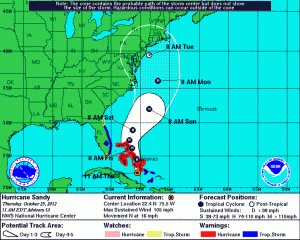
A new study published online this week in the scientific journal, Scientific Reports, says the threat of significant, landfalling hurricanes in the northeastern US is on the rise. The study led by Durham University (UK) describes how hurricanes have gradually moved northwards from the western Caribbean towards northern North America over the past few hundred years; the researchers suggest that this change in hurricane track was caused by the expansion of atmospheric circulation belts, perhaps driven by increasing CO2 emissions. The researchers added that New York City and other major cities in the northeastern United States could come under increased threat from these tropical cyclones and that they need to be better prepared for potential impact of such tropical cyclones.
Researchers involved with the study reconstructed hurricane rainfall for the western Caribbean dating back 450 years by analyzing the chemical composition of a stalagmites collected from a cave in southern Belize, Central America. They found that the average number of hurricanes at the Belize site decreased over time. When the hurricane history of Belize was compared with documentary hurricane records from places such as Bermuda and Florida, this information showed that Atlantic (Cape Verde) hurricanes were moving to the north rather than decreasing in total numbers.
These same researchers found a marked decrease in hurricane activity in the western Caribbean coinciding with the late 19th Century industrial boom which lead to increasing carbon dioxide and sulphate aerosol emissions into the atmosphere. The study scientists said that initial regional cooling of the Northern Hemisphere due to increased industrial aerosol emissions should have pushed the hurricane tracks southward since Industrialization, but added that rising amounts of atmospheric carbon dioxide had overridden this effect by expanding the Hadley cell. a weather pattern of circulating air in the Earth’s tropical belt, pushing hurricane tracks further north. This northerly track pushed hurricanes away from the western Caribbean and towards the northeastern US. This suggests that if future trends of industrial aerosol emissions and carbon dioxide continue, hurricanes could shift even further north. A more northerly shift would increase risks of landfalling hurricanes to places such as Delaware, New Jersey, New York, Connecticut, Rhode Island, Massachusetts, New Hampshire, and Maine.
The study’s lead author, Dr Lisa Baldini, in the Department of Geography, Durham University, said: “Our research shows that the hurricane risk to the Northeastern coast of the United States is increasing as hurricanes track further north. Since the 19th Century this shift was largely driven by man-made emissions and if these emissions continue as expected this will result in more frequent and powerful storms affecting the financial and population centers of the Northeastern United States. Given the devastation caused by Hurricane Sandy it is important that plans are put in place to protect against the effects of similarly destructive storms which could potentially occur more often in the future.”
In recent time, the most noteworthy storm to strike the northeast was Sandy in 2012. While it was a hurricane when it hit the Caribbean, it weakened below hurricane strength when it came ashore near Brigantine, New Jersey. That storm claimed 233 lives and cost over $75billion in damages, making it the second costliest tropical system to ever impact the United States.
Co-author Dr Amy Frappier, of the Geosciences Department, of US-based Skidmore College, said the research showed Atlantic hurricanes were responding to warming. Dr Frappier said, “Aerosols from volcanoes and industrialization in the Northern Hemisphere have a cooling effect, which tend to shift moisture belts and hurricane tracks southward, closer to the equator. On the other hand, warming from more carbon dioxide in the air tends to expand the Earth’s tropical belt, pushing hurricane tracks further north away from the western Caribbean and towards the Northeastern US. This suggests that the tracks of Atlantic hurricanes have responded more to warming than to regional cooling.”
The study was received in May of this year prior to the start of a relatively busy Atlantic Hurricane Season. The 2016 Atlantic hurricane season is the most active and costliest Atlantic hurricane season since 2012 as well as the deadliest since 2005. To date, the season had produced a total of 16 storms, 15 of which were named. Of those named systems, seven were hurricanes and three were major hurricanes. The season officially started on June 1 and will end on November 30. The “season” began nearly five months before the official start, with Hurricane Alex forming in the Northeastern Atlantic in mid-January, the first Atlantic January hurricane since Hurricane Alice in 1955. The study was accepted at the end of October and published online on November 23.
Visit our Tropical Weather Page here for further information about this system and a review of all tropical cyclones that were near US waters for the 2016 season: https://weatherboy.com/hurricanes-tropical-weather/